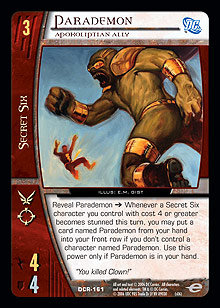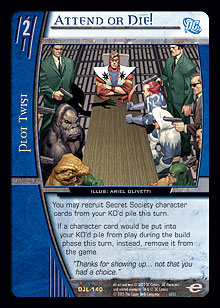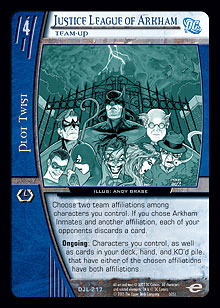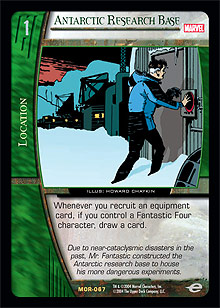As R&D promised on Friday, we’ve prepared a full account of the reasoning behind the recent erratum, rules change, and bannings. We wanted to address your concerns as fully as possible. Much like Rama-Tut and Overload from a year ago, the latest wave of bannings comes paired with an erratum. This article will dive into the differences between the two cases and explain the reasons for the most recent examples.
There are two general ways in which cards we’ve made can become problematic. The first is when a card doesn’t work the way the designers and developers intended it to work. The second is when a card is doing things that are too powerful, often in ways that foster negative play experiences and restrict future card designs.
Card Intent
The cards we print all go through a similar process. They start off in the mind of a designer, who writes those ideas into a file. If there’s any confusion on the wording, the developers confirm what the designer wants the card to do before proceeding with playtesting. As playtesting progresses, there may be tweaks to a card as we realize that the original design is too good or too weak. We then reach an agreement on which aspects of the card to keep and which to discard. Finally, the rules team gets their hands on the file and makes sure that the cards work correctly in the rules and give us a reality check on situations they see arising. They’ll make sure that we’re okay with the outcomes the rules produce for various scenarios that we might not have considered.
Templating
Each time we create something new, we are challenged by the best way to template a card. What if we want a card to be used only during a first attack? What if we want a card to trigger from your hand? Sometimes this is a matter of clearly wording the card for our rules. At other times, the challenge is not only the wording but also making sure it doesn’t “break” without other cards. How can we make a character that doesn’t exhaust to attack? How can we make a character that makes you lose a resource only while it is in play?
 Cards like these are historically some of the coolest in the game. But the risk in making them is that we will miss interactions because of the way we have to write them. For example, in the case of Parademon, Apokoliptian Ally, the initial intent of the card was to put it into play whenever you had a high-cost character stunned. Seems pretty simple, right? Unfortunately, things are not always as simple as they appear.
Cards like these are historically some of the coolest in the game. But the risk in making them is that we will miss interactions because of the way we have to write them. For example, in the case of Parademon, Apokoliptian Ally, the initial intent of the card was to put it into play whenever you had a high-cost character stunned. Seems pretty simple, right? Unfortunately, things are not always as simple as they appear.
Eventually, we came up with the printed version of the card. It looked like it was capturing exactly what we wanted. What we’d missed, or at least failed to foresee as a problem, was that you could reveal this card any number of times, setting up multiple triggers off of a single event and allowing you to put a card named Parademon into play. So, with a card like Callisto, you could keep returning copies of Parademon to your hand so that you would have a copy to put into play each time the effect resolved. By using “reveal” from your hand, we’d trapped ourselves because we couldn’t say, “Use this power only once per turn.” Because after you’d finished revealing it, who’s to say that the next one you revealed would be the same one? It also forced us to refer to a character card “named” Parademon, rather than Parademon (referring to the card itself), since again there’s no way prove it is the same card once it is hidden back in your hand. It’s possible that we could have addressed these issues with a rules change about keeping cards revealed, but changing rules for the sake of a single card is something we try to avoid without additional reasons.
So in this case, we had a card not working at all as R&D had envisioned that was capable of producing infinitely large characters on turn 6. In my mind, that is enough reason to take action on the card. Add to this the fact that it would be exceedingly difficult to stop that interaction, and we simply had to choose the appropriate fix for the situation.
By and large, when a card is not working as intended because of our choice of templating, we will try to fix it by errata’ing the card, not by banning it or by changing the rules (unless we think it will help us open up more design space with similarly worded cards). If we are making an erratum, we want to make sure that the card will play the same in the vast majority of circumstances. What does the “vast majority of circumstances” mean? Ultimately, this is not a clear-cut issue. It’s a judgment call that R&D has to make based on experience and playtesting.
With Parademon, we’ve chosen to errata it to remove the card from the game as the cost instead of revealing it:
Remove Parademon from the game >>> Whenever a Secret Six character you control with cost 4 or greater becomes stunned this turn, you may put Parademon into your front row if you don't control a character named Parademon. Use this power only if Parademon is in your hand.
Rules
It almost goes without saying that the rules of our game fundamentally affect how all of our cards are played. As much as possible, we want the rules of our games to produce intuitive outcomes when you play.
At the recent Pro Circuit, players were KO’ing their Checkmate Kings to pay costs on cards, relying on cards like Threat Neutralized to get around the drawback of cards like Ahmed Samsarra. Unbeknownst to some of these players, there is a rule stating the following:
203.9 Actions taken to pay costs can’t be replaced. If a replacement modifier attempts to replace part or all of a cost, none of that cost is replaced.
Example: Tim Drake ◊ Robin, Young Detective reads, “If a team attacker you control would become stunned, instead, you may stun another team attacker you control.” A team attacker you control with evasion can’t have the cost of evasion, “Stun this character,” replaced by Tim Drake’s power’s replacement modifier. To use the character’s evasion, you must stun that particular character, and you cannot “redirect” the stunning to another team attacker you control.
So, if you are to pay the cost on a card like Poison Ivy, Deadly Rose, which requires a KO (where KO is defined as “an event that instructs a player to place an object into his or her KO’d pile zone. Not all events that place an object in the KO’d pile are KO events.”), then that cost cannot be replaced by Threat Neutralized by the above rules, so the card still goes to the KO’d pile. And if you used a Checkmate King to pay the cost, you’ve just cost yourself the game.
When we designed and developed Threat Neutralized, we wanted it to hit all cards that were going to the KO’d pile from play, regardless of how they were getting there. Certainly, we in R&D didn’t want costs to be an exception to this. It wasn’t just this card that led to the rules change, however. Besides this interaction, we had lost sight of this rule and had made another card that assumed that KO’ing characters as a cost did get replaced by replacement effects.
 Take a look at Attend or Die!. It reads, “You may recruit Secret Society character cards from your KO'd pile this turn. If a character card would be put into your KO'd pile from play during the build phase this turn, instead, remove it from the game.”
Take a look at Attend or Die!. It reads, “You may recruit Secret Society character cards from your KO'd pile this turn. If a character card would be put into your KO'd pile from play during the build phase this turn, instead, remove it from the game.”
When a designer wanted to make a card that allowed you to play character cards from your KO’d pile, we immediately caught that there’d need to be a way to stop those characters you recruited from going back to the KO’d pile and being recruited again, especially if they were effectively free. So, we thought we’d found a way that we could make this card by saying that character cards put into your KO’d pile would be removed from the game instead. But we were not considering that character cards would still get put there if they’d been KO’d as part of a cost.
Let’s just say that, if you had to think about the best possible draw you might have had at PC: San Francisco, it very well could have included Mr. Mxyzptlk, Fifth Dimension Imp; Attend or Die!; and Devil’s Due. I’ll let you fill in the rest of the pieces and figure out the earliest turn you could have had several infinitely large characters this past week.
For these reasons, we’ve made the following change in the Comprehensive Rules:
203.9b If an object would be KO'd in order to pay a cost, a replacement modifier can replace the event of putting that object into a KO'd pile, and that cost is still considered to have been paid. This is an exception to 203.9 and 513.5d.
So, as far as cards not working as intended, this is why you saw us act quickly after the PC with the erratum and rules change we announced.
Power Level
In contrast to the cards I described above that were not working as intended, we have another class of cards that have become abusive in our tournament environments based on power level.
What makes a card too powerful? There is no easy answer here. The starting point is actually deciding that there is a problem. For the most part, we perceive a problem existing when a deck seems to be dominating a format and/or that deck is doing something beyond the scope of what we “want” decks to be doing. Then it is a matter of figuring out which cards must be dealt with to solve this problem such that we hurt as few other “honest” decks as possible and prevent the problem from recurring in the future.
In the case of this week, we chose to take action against two decks that were encouraging negative play patterns. One of these decks was the “Ivy League” / “Killing Joke” deck that has shown itself to be a strong force, placing four decks in the Top 8 of PC: San Francisco and winning $10K Hamilton this past weekend even when many players were well-prepared for it. Ultimately, we don’t want players to be forced into dealing with narrow answers like Sage, Tessa and Bad Press to avoid having no hand and no resource on turn 4. In banning Justice League of Arkham, we are not saying that it can’t be beat some amount of the time by players prepared for it; we are saying that we think it is a bad thing for our players to have to “deal with” at our events.
 On the face of it, there doesn’t seem to be anything too powerful about . It makes you discard a card. That doesn’t seem like it could be the problem, one can argue. I’m sure many of our players feel that the real culprit is a card like Dr. Light, Master of Holograms, which enables all of the action going on in that deck. While there is truth to this, we are trying to fix a situation where players are missing a chance to play resources and/or characters. Do players get too much for 3 resource points with Dr. Light? Maybe, but at least for now we feel it isn’t clear that further action needs to be taken with him to fix our existing tournament formats. Ultimately, if we are defining the problem as players being forced to miss resource and/or character drops, we can solve the problem by taking Justice League of Arkham out of the equation. We’d given it the privilege of being a Team-Up, and having made many cards that fetch Team-Ups, along with cards like Hope, Justice League of Arkham was simply too easy to search out and re-use. And when it was re-used, it resulted in very negative play experiences for players.
On the face of it, there doesn’t seem to be anything too powerful about . It makes you discard a card. That doesn’t seem like it could be the problem, one can argue. I’m sure many of our players feel that the real culprit is a card like Dr. Light, Master of Holograms, which enables all of the action going on in that deck. While there is truth to this, we are trying to fix a situation where players are missing a chance to play resources and/or characters. Do players get too much for 3 resource points with Dr. Light? Maybe, but at least for now we feel it isn’t clear that further action needs to be taken with him to fix our existing tournament formats. Ultimately, if we are defining the problem as players being forced to miss resource and/or character drops, we can solve the problem by taking Justice League of Arkham out of the equation. We’d given it the privilege of being a Team-Up, and having made many cards that fetch Team-Ups, along with cards like Hope, Justice League of Arkham was simply too easy to search out and re-use. And when it was re-used, it resulted in very negative play experiences for players.
The other problematic deck we saw was centered around equipment and could draw far too many cards with Antarctic Research Base. The Base has been a concern for us for a very long time. While the Fate Artifacts were ultimately what put this deck over the top, we had built many decks previously that were scary with this card. What Antarctic Research Base lets you do is dangerous. This isn’t to say that there aren’t honest applications of the card. Each set brings more 0-cost equipment. Assuming you have a means to keep playing equipment on your characters by getting around the one-equipment-per-character restriction or by KO’ing equipment you have in play, you can turn each equipment drawn into the next card in your deck. And there is no limit to this process. We don’t want players drawing their entire deck early in a game. While the Fate Artifacts make this a more reasonable and frequent occurrence, there are certainly decks that can be built to do this in a less consistent fashion without them. Again, this does not exclude the possibility that other cards, such as the Fate Artifacts, are too powerful as well, but in our opinion, that remains to be seen. We do feel safe in concluding that consistently drawing your whole deck on turn 3 is problematic, as is forcing your opponent to discard seven cards on turn 4 before he or she has played a resource.
Whether or not you agree with us that any action had to be taken or that these are the correct cards to take action on, there is still one big question: did we really have to ban these cards? The bottom line is that we don’t want to make a practice of developing our cards after we’ve printed them. We don’t want to keep adding lines of text to cards that players must memorize, especially when they’ve been played differently in the past. There are some grey areas on this topic, and at times we will choose to use errata if we think it will be very easy on our players. We’ve made some fairly functional errata so that players can keep playing with their cards.
In the course of normal play, how often will Rama-Tut, Pharaoh from the 30th Century come into play when you did not recruit him? How often will Dr. Light, Master of Holograms be used more than once per turn? What is the burden on the player having to know the errata on these cards as opposed to just banning them?
Let’s look at how we might have errata’d the two cards we banned. I believe our best case for Justice League of Arkham was the following:
“Choose two team affiliations among characters you control. If you play Justice League of Arkham during the combat phase and you choose Arkham Inmates and another affiliation, each of your opponents discards a card.”
Frankly, I think this is too big a leap of faith from the original card. We considered many other options, but they were even more extreme. If all of our other discard effects in the game had also been limited to the combat phase, it would be easy to justify this change to our players, but that is simply not the case. Ideally, we could sync up all cards so that you couldn’t force players to discard between when they draw and when they play a resource, but this would result in quite substantial errata on cards like The Penguin, Arms Merchant and Search and Destroy.
 Similarly, for Antarctic Research Base, the solution might have been something like the following:
Similarly, for Antarctic Research Base, the solution might have been something like the following:
“Whenever you recruit an equipment, if you control a Fantastic Four character, draw a card. This power triggers only once per turn.”
Other attempts at an erratum could reference Fate Artifacts or non-unique equipment, but that would be very conspicuous and unintuitive. It also still wouldn’t address the issues that exist with the power level of Antarctic Research Base and the rest of our card pool. With these possible errata, we again felt that the card would be operating too differently from how it used to, requiring players to re-learn how the card worked.
While this is not a hard and fast rule, when we are addressing cards that are not functioning as intended, we will most frequently errata them, and when they have reached a point where they are too powerful in our game, they will be banned. There will be exceptions when we think it is in the interest of our players. You can find some additional explanations of why this is the case in Danny Mandel’s article on why we need to make errata.
A final thing to note is that our banned cards will be banned in all Constructed formats. We will not (at least at this time) be having separate banned lists for our various Constructed formats, so there is only a single list our players need to be aware of. As far as the banned cards are concerned, we will do our best to create new cards to fill the roles of the cards we’ve banned. Our hope is that the “fair” deck types our players enjoyed that were hurt by these changes will soon be available again. As always, we would appreciate any feedback on these topics. Please contact me at DHumpherys@metagame.com if you have feedback about the decisions we’ve made.